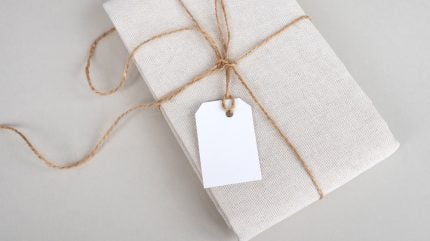
As sustainability moves from niche interest to mainstream necessity, businesses are seeking packaging solutions that go beyond single-use plastics and uninspiring cardboard.
Textile packaging, an increasingly popular choice across fashion, cosmetics, and luxury sectors, offers a compelling balance between functionality and aesthetics. It not only safeguards delicate goods during transit but also reinforces brand identity and appeals to eco-conscious consumers.

Discover B2B Marketing That Performs
Combine business intelligence and editorial excellence to reach engaged professionals across 36 leading media platforms.
From reusable cotton bags to sophisticated jute wraps, textile-based packaging solutions are redefining what it means to deliver products with care and style.
While protective performance remains key, the enduring value of textile packaging lies in its visual appeal, longevity, and low environmental footprint.
Sustainable appeal meets consumer demand
The rise in sustainable packaging is no coincidence. With global consumers becoming more discerning about the environmental impact of their purchases, businesses are under pressure to adopt greener practices.
Textile packaging offers a compelling answer. Reusable, biodegradable, and often made from natural or recycled fibres, these materials provide a lower-waste alternative to plastic and paper while maintaining high-quality presentation.

US Tariffs are shifting - will you react or anticipate?
Don’t let policy changes catch you off guard. Stay proactive with real-time data and expert analysis.
By GlobalDataNatural fabrics such as organic cotton, hemp, and linen are commonly used, often sourced from renewable crops with minimal processing.
For brands seeking circularity, recycled PET fabrics—made from post-consumer plastic bottles—combine eco-friendly messaging with durability. Textile packaging can be easily reused by consumers for storage or travel, creating a lasting brand presence long after the initial unboxing.
Crucially, textile-based options are not just sustainable in theory. A growing number of studies and case reports show that reusable fabric packaging leads to significant reductions in waste and carbon emissions over time.
This aligns with rising SEO search interest in terms such as “eco-friendly packaging”, “sustainable packaging materials”, and “reusable product packaging”.
Protective benefits beyond the surface
While the visual and ecological appeal of textile packaging is clear, its practical advantages are equally significant. High-quality textiles offer superior protection for delicate items.
Padded cotton sleeves, drawstring bags, and multi-layered wraps can cushion goods against knocks, scratches, and moisture—an important factor for sectors such as jewellery, cosmetics, electronics, and premium food items.
Textiles can also be tailored to the shape and size of a product with far more flexibility than rigid packaging materials. This not only enhances product security during shipping but also minimises the need for bulky void-fillers or secondary wrapping, contributing to a leaner packaging profile.
As e-commerce continues to grow, these efficiency gains have financial and environmental implications alike.
Moreover, fabric’s breathability helps prevent the build-up of condensation, which is especially valuable when packaging organic or artisanal goods. This feature makes textile packaging a smart choice for brands that prioritise freshness and authenticity, while still maintaining a polished, high-end look.
A powerful tool for brand storytelling
Beyond its eco-credentials and functionality, textile packaging shines as a tool for visual identity and consumer engagement.
Unlike conventional packaging, which is often discarded, fabric wrappers, pouches, and custom totes can become part of a product’s journey, turning packaging into a keepsake rather than waste.
This is particularly true in sectors where unboxing experiences play a critical role. Fashion brands, for instance, use custom-printed garment bags or branded cotton dust covers to elevate the perceived value of their products.
Luxury skincare lines often present their items in soft pouches with embroidered logos, adding a tactile element that appeals to high-end customers.
Even smaller businesses and artisan makers can benefit. With access to cost-effective digital printing and small-batch manufacturing, it’s now easier than ever to create bespoke textile packaging that reflects a brand’s personality and values.
Whether it’s minimalist monochrome linen or colourful hand-dyed wraps, the choice of textile tells a story—and customers are listening.
The long-term marketing impact of this approach shouldn’t be underestimated. With search traffic for phrases like “custom textile packaging” and “branded fabric bags” on the rise, it’s clear that consumers are increasingly drawn to packaging that’s both beautiful and reusable.
This connection between packaging design and brand loyalty represents a key opportunity for businesses aiming to stand out in crowded marketplaces.
Final thoughts
Textile packaging stands at the intersection of sustainability, protection, and style—three factors that are increasingly important to modern consumers.
It provides brands with a dynamic way to reduce their environmental footprint, safeguard their products, and make a lasting impression on their customers.
As more businesses explore alternatives to single-use packaging, textile-based solutions are proving to be more than a passing trend.
Their blend of form and function offers a future-proof strategy for companies that want to align with evolving values while delivering on quality and aesthetics.
For brands looking to combine environmental responsibility with visual storytelling, textile packaging is a natural choice.





